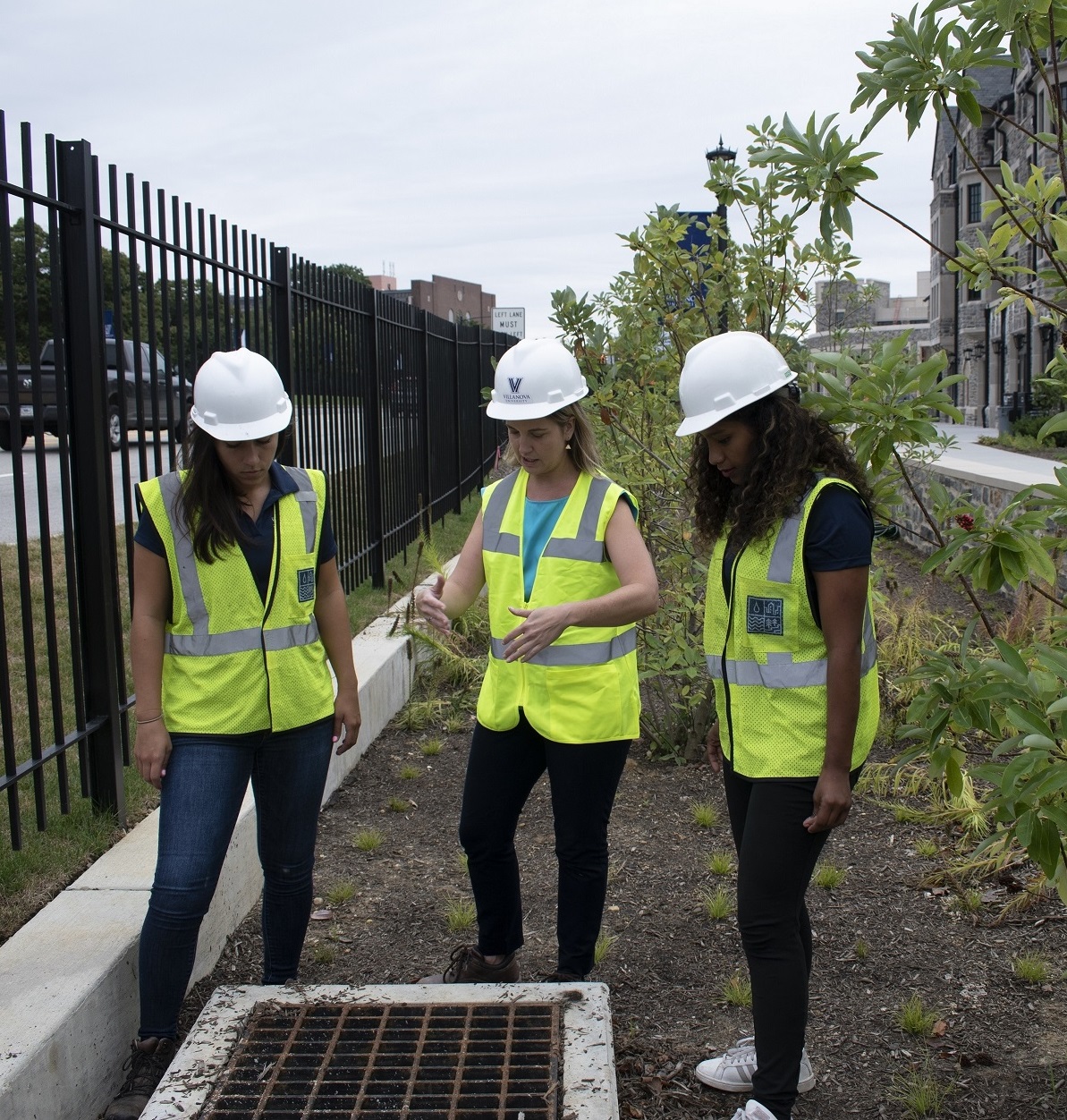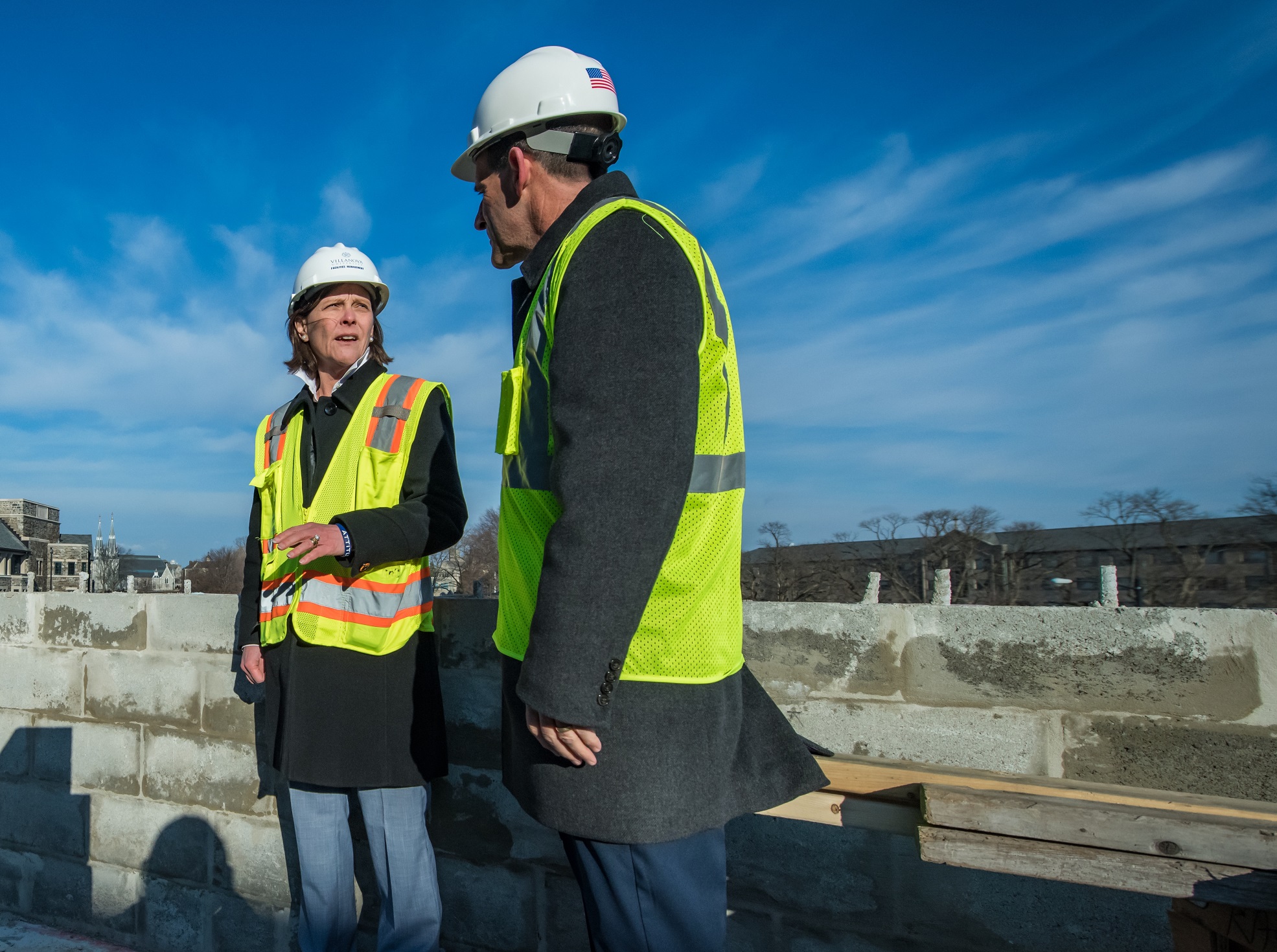Campus Collaboration: Newly Completed Residence Hall Community also a Living Laboratory for Engineering Stormwater Management Research
A long-standing relationship between Villanova’s Facilities Management Department and the College of Engineering is a symbiotic one, resulting in numerous stormwater research sites and shared knowledge.

Dr. Bridget Wadzuk, professor of Civil and Environmental Engineering, talks with students about how the bioswales located in front of The Commons capture stormwater water from an adjacent roadway.
Faculty in Villanova University’s College of Engineering have been leading the way on stormwater management research for more than two decades. Their research is funded by the NSF and EPA among others, and the results of their work have helped to advance stormwater management practices on campus and throughout the country. Villanova Engineers are actively contributing to stormwater management guidelines in Pennsylvania, as well as other cities and states across the U.S. The research has also had an impact on the way the University approaches its facilities projects.
“This is something that our Engineering faculty have been teaching and preaching for decades,” said Marilou Smith, Senior Project Manager in Facilities Management. “It’s part of our DNA now. We try to find ways in every project, within our means, to be as sustainable as possible.”
This month, Villanova opened a new residential community called The Commons, a $225 million transformation of the institution’s former surface parking lots along Lancaster Avenue/Rt. 30. In its place are six apartment-style residence halls that house 1,135 students.
A key aspect of The Commons is its sustainable design and benefits. For instance, two cisterns will take stormwater from the roofs, filter the water and re-used to cool the buildings. Three bioswales along Lancaster Avenue, designed as walls with seating, will remove debris and pollution from surface water runoff. In all, it is estimated that 400,000 gallons of water can be saved each year with this sustainable infrastructure.
“This is a really interesting way to manage stormwater in a way we haven’t used in the past,” said Smith, who served as project manager for The Commons. “By using the rainwater and filtering it to cool the buildings, we are managing stormwater runoff and we don’t have the need to purchase cooling tower water.”
The University’s Facilities Management Department worked with a civil engineering firm on the stormwater management systems for The Commons. They also tapped into the expertise of the Villanova Engineering faculty. For instance, Dr. Robert Traver, a professor of Civil and Environmental Engineering, suggested the bioswales as a proactive way to capture the stormwater water from an adjacent roadway.
The relationship between Facilities and Engineering is symbiotic. What makes this collaboration especially unique are the ongoing efforts by Facilities Management to support the College of Engineering and its faculty on the research front. Facilities continues to incorporate stormwater test sites into its new construction and renovation projects for the benefit of Engineering’s long-standing research in this area. These new sites become part of the College of Engineering’s Stormwater Control Measure Research and Demonstration Park.
This partnership began two decades ago when the first stormwater control measure test site was built on campus. In 1999, an existing stormwater detention basin on campus was converted into an extended detention wetland. A bio-infiltration stormwater control measure was constructed in 2001 by retrofitting an existing traffic island. The College of Engineering has been capturing continuous data on this site since 2003—making it one of the longest monitored green infrastructure sites in the country. Now, nearly 20 years since the first campus test site was built, numerous test sites are actively being monitored across campus.
This research is also providing benefits to the campus overall. Facilities continues using the knowledge gained from Engineering’s research to identify the best solutions for projects.

Marilou Smith, senior project manager in facilities management, was the project manager for The Commons. Above, Smith discusses the construction with Robert Morro, vice president for Facilities Management.
“We are an institution of higher learning and it is fulfilling working with our Engineering faculty and students in this way,” said Smith. “These are great opportunities for our students to see what we do and for us to see what our faculty and students learn from their research on these sites.”
The Commons have a number of test sites that allow faculty and students to study the impact of the stormwater management systems. Both before and during construction, graduate students monitored rainfall and water flow patterns on the site to see how much stormwater runoff was being contributed to nearby sewer systems. Now with multiple new green stormwater infrastructure methods in place, students will continue monitoring the site to verify the effectiveness of the new systems. This will allow students and faculty to evaluate how much stormwater is being captured by vegetative systems on site, rather than contributing the excess water to local sewer systems. The goal of this research is to determine how green stormwater infrastructure techniques react to previously ultra-urban conditions.
“There has been a lot of collaboration and shared knowledge working together [with Facilities] on campus over the last 20 years,” said Dr. Bridget Wadzuk, professor of Civil and Environmental Engineering. “When projects arise, we want to be part of it and engaged in it. There are times when we even ask to be involved and they continue to provide us great opportunities. This is the nexus of 20 years working together.”
“For the first 10 years of our work, I would say that 99 percent of our research happened on campus,” continued Wadzuk. “These campus sites have helped enable us to get external funding and we are now doing research on I-95, the Delaware River Watershed and other locations. I think this is probably the most successful marrying of facilities and academia there is.”
Despite its location in the suburbs, Villanova is an urban site because of the density of its campus. As such, the research being conducted on campus has proven extremely beneficial externally. The University continues to share best management practices with organizations such as PennDot, as well as township officials, municipalities and other organizations through a cooperative called the Villanova Urban Stormwater Partnership (VUSP). With a focus on research and public education, VUSP regularly hosts groups to discuss best practices and provide tours of the University’s stormwater test sites.
“We want the whole campus to be our research playground,” said Dr. Traver, who also directs the Villanova Urban Stormwater Partnership. “And the support we receive has allowed us to use the campus extensively for our research.”
